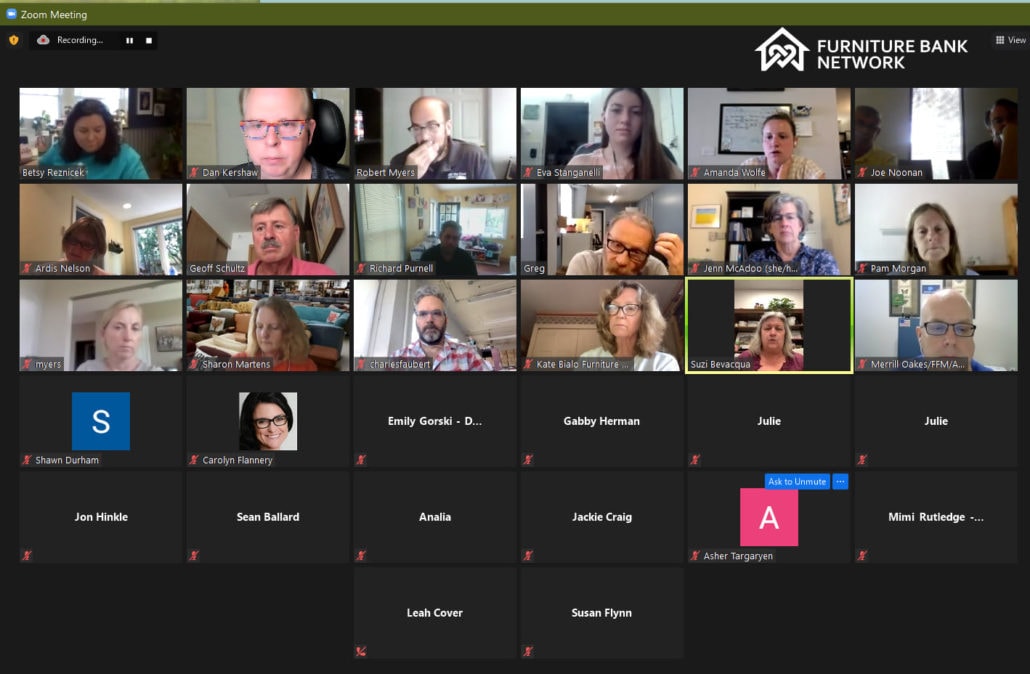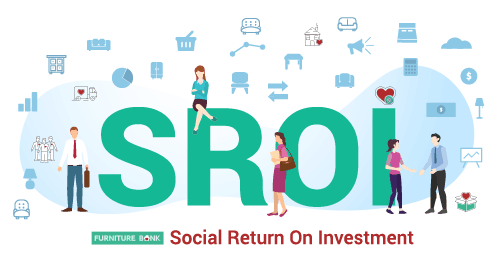The new COVID world shifted how we operate and help families get the furniture they need, but it also changed how we share our struggles and wins. In an ideal situation, a group of us would meet, have a human-to-human connection, and discuss what’s going on within the furniture bank industry.
Instead, like many businesses, a shift to online collaboration was needed. Recently, we held a Furniture Bank Roundtable to discuss how the pandemic has affected furniture banks. A collection of 17 furniture banks gathered via Zoom to talk about:
- Pandemic challenges
- Online-style shopping systems
- In-person appointments vs. solution curation
- Specific data points funders want
- Pivot opportunities during the pandemic and additional partnerships
Pandemic Challenges
Hiring drivers and truck teams was a common challenge among all furniture banks. Even a pay increase of 50% couldn’t draw the attention of potential employees. Some of these hiring challenges were so severe that one furniture bank had to shut down for a small period due to their lack of crew available. While things have progressed positively from that low point, these are still prominent challenges many furniture banks are trying to overcome.
Client referrals from agency partners were also affected during the pandemic. Some furniture banks attribute this to a common summer trend since schools are closed and many social workers are on holiday. However, others felt the impact more throughout the pandemic. The good news is that referrals seem to be trending upward and stabilizing to normal numbers.
Online Furniture Showcase
Online sales are up 112% in Canada from last year. This trend doesn’t exclude Furniture Banks. Digital systems, where furniture banks put together room vignettes or highlight available furniture, was a hot topic during this discussion. Much of the intrigue surrounded the technology and efficiency of keeping a digital repository of the available furniture.
At New Life Furniture Bank of MA, they take pictures of all available furniture so recipients can digitally shop for something they like and want in their homes. After moving away from WordPress, they found a system that works to photograph each furniture item that comes in and jot down its measurements to ensure it will fit in the client’s home. The system they set up enabled them to do more with less as volunteers could do this more efficiently than having a dedicated helper do an in-person walkthrough. Additionally, it helps retain volunteers. Often volunteers are college students who are gone for the summer. Having a digital system enables them to volunteer from anywhere with an internet connection.
Note: Other suggestions were to use an online store from Square App to expedite the online repository.
Individuals or families needing furniture and caseworkers like the online shopping model as well. Individuals or parents are often busy working and don’t want to or can’t afford to take time off work to do an in-person shop-through. An online shopping model allows them to find the time in their schedule while still giving them choice – a strong desire for anyone building the foundations for turning their house into a home.
To ensure furniture doesn’t come back, a caseworker or social worker must help ensure furniture will fit in the home. A home inspection is needed to determine sizes before the client’s online shopping experience. This is also why the pictures and dimensions of the furniture available are so important. It reduces the risk of furniture not fitting into the home upon delivery. Efficiency is the name of the game when running on limited budgets.
In-person Appointments Versus Solution Curation
Shop throughs are down due to COVID-19. A surprising outcome from this is increased efficiency regarding furniture allocation. Instead of assisting the people using our services when they come in for an in-person walkthrough, the online shopping and curation models allow for less time spent throughout the selection process.
The online model discussed above differs from the curation model. After talking to the client, a furniture bank member picks out the furniture based on the conversation, trying to meet the client’s needs as best they can with the available furniture.
The Oyate Tipi Furniture Bank also noted that online/curation reduces missed deliveries. Setting delivery times after the shop-through are challenging. However, with the online or curation model, a delivery time is set during the consultation, drastically reducing some of their delivery challenges.
Nevertheless, there are still individuals and families that want to come in and pick out their furniture. Therefore, moving forward, a hybrid model is likely to become the norm moving into a post-pandemic world.
Varying Data Points Funders Want (A.K.A. Outcome Related Measurement)
The pandemic relaxed many funders’ stipulations as they recognized the need for flexibility in a time of crisis. However, as things slowly start to get back to a semblance of normalcy, many of these stipulations are returning. An example given was a specific donor’s restriction on using funds specifically for children’s beds. These stipulations relaxed at the beginning of the pandemic but are beginning to return.
Additionally, other metrics are being asked of by furniture banks. The standard used to be how many households served or individuals helped. Now, further information is requested, if not required to get grants and funding. Was there a return to homelessness? Or was there an impact on health or behaviours after furnishing an individual or family? Most of these questions are often difficult to answer. Exit surveys seem to be the most accurate form of proving these numbers. However, they are often difficult to get (especially after six months).
Social return on investment is an option to highlight the value of furniture banks. In the case of Furniture Bank (located in Toronto), they’ve been able to prove that for every $1 donated or invested into Furniture Bank, the charity creates $12.11 worth of benefits back to society.
The environmental element is equally as important. Carbon offsetting is another potential metric avenue. Furniture Bank helps “divert more than 1500 tonnes of material from Toronto landfills annually.” Highlighting the (literal) tonnes of waste not sent to landfills or highlighting the emissions saved from recycled or reused items rather than destroyed is another effective tool for potential grants and donors.
Ultimately, while a challenging task, the best-case scenario is a combined, standardized impact measurement methodology that all furniture banks can use. The collective whole highlights the good we all do to improve society and make everyone’s house feel like a home.
Additional Opportunities and Partnerships
The beginning of the pandemic led Welcome Collective to pivot delivery services from furniture to food. Because of their delivery infrastructure, they were able to step in when food banks and other options weren’t available to those who needed it when places were closed and stay at home orders were mandated. Even though this isn’t a continued offering, these actions elevated Welcome Collective’s visibility within the community. In some situations, cross collaborations are essential to raise the visibility and importance of furnishings within communities.
The Stock the Pantry initiative by The Green Chair Project is an ongoing partnership with local food banks to provide food with every furniture delivery. If most people don’t have furniture in their new home, it’s also likely they don’t have food.
Regardless of when these partnerships happened (before or after the pandemic), furniture banks should be looking for additional opportunities to make inroads within the community.
Whether we’re working together as a network of furniture banks or with other organizations within your local communities, the goal is to make our society better. As we keep the conversations going, this should always be our primary outcome – pre-pandemic, during a pandemic, and post-pandemic.






